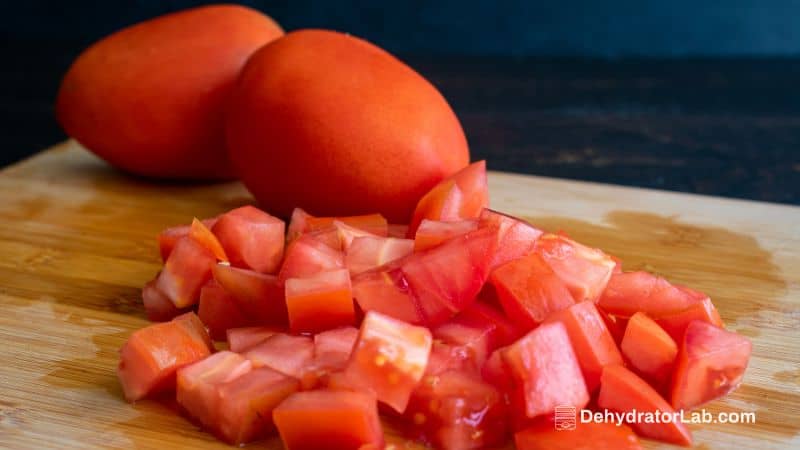In today’s tutorial, we’re going to demonstrate how to dehydrate bell peppers effectively. If you’re a fan of camping or simply like to keep your pantry well-stocked, this guide is for you.
The procedure we’ll cover applies to red, orange, and yellow bell peppers, as they all dehydrate well.

As an Amazon Associate, I earn from qualifying purchases. If you make a purchase after clicking on a link I may earn a small commission at no extra cost to you if items are purchased.
In this article:
Key Points on How to Dehydrate Bell Peppers[TL; DR]
- 🫑 Dehydrated bell peppers are a great addition to camping meals as they rehydrate well and add flavor to dishes.
- 🌡️ The temperature control on the dehydrator can be adjusted, with the recommended setting for bell peppers being 135 degrees Fahrenheit.
- 🌶️ Dehydrating vegetables like bell peppers is a great way to reduce food waste and make use of the parts that are typically discarded.
- 🛒 Dehydrating bell peppers can significantly reduce their weight and size, making them ideal for long-term food storage or for taking on trips.
Versatile Ingredients
Dehydrated bell peppers are incredibly versatile. They’re great to use in pizzas, chilies, soups, stews, casseroles, and other dishes. They add a burst of flavor and color to your meals without the need for fresh ingredients.
They are also excellent for camping trips or emergency food supplies, as they’re lightweight and don’t require refrigeration.
Gathering Your Ingredients
Firstly, let’s talk about what you’ll need:
- A mix of bell peppers (red, orange, and yellow)
- A food dehydrator (see our reviews)
- Kitchen knife
- Cutting board
- Plastic Ziploc bag
A great time to try this out is when bell peppers are on sale. Not only can you get them for less, but you can also stock up and preserve them for future use.
It was just another day when I visited the market and saw a sale on green peppers. With just $1 for each package, it was a bargain I couldn’t ignore. I realized then, I didn’t have any dehydrated peppers at home. Knowing I frequently use them for making pizza and chili, it would be beneficial to stock up. Thus, my journey into the world of dehydrating bell peppers began.
Preparation Process
To kick things off, I prepared the essentials. I started by bringing water to a boil for blanching the peppers. Meanwhile, I proceeded to unpack the peppers, gave them a good rinse, and then planned to dice them.
Now, a common question at this point is: How many bell peppers will you need? This will vary depending on the size of your dehydrator.
For the sake of this guide, we’ll be using a weight-based measurement. Before loading the peppers onto the dehydrator trays, weigh them all. Keep a note of this weight; you’ll be comparing it with the weight of the dehydrated peppers later on.
Cutting and Cleaning
Initially, I quartered the bell peppers, which seemed a more manageable size for removing the seeds. This relatively quick and straightforward process involved cutting away the inside, effectively ridding the peppers of all their seeds.

Once all the peppers were cleaned up, I, cut the bell peppers into slices and then into chunks and set them aside. These should ideally be no more than half an inch long – think the size of a broccoli floret.
Remember, the aim here is to ensure that they can rehydrate well later. Therefore, the air should be able to circulate freely. We’ll delve deeper into rehydration methods later on.
Blanching the Bell Peppers
I noticed my water had come to a rolling boil, signaling the perfect time to blanch the diced peppers. The blanching process was simple: a quick dip in boiling water followed by an immediate plunge into cold water.
However, instead of doing them all simultaneously, I decided to blanch the peppers in small batches.
There was no need for precise cutting at this stage, as they could be made even smaller post the dehydration process if needed.
Once your peppers are sufficiently blanched, remove them from the boiling water and plunge them into cold water. This step helps to stop the cooking process and prepares them for dehydration.
Loading the Dehydrator
With the first batch of peppers blanched, I spread them evenly on my dehydrator tray. It was crucial not to overcrowd the tray to ensure optimal dehydration; remember, the air needs to flow freely around each piece.
Then, I moved on to blanching the next batch of peppers. This rhythm continued, batch by batch until all the peppers were blanched and loaded onto the dehydrator trays.
Dehydration Process
The last of my blanched peppers made it onto the final tray, again making sure not to overcrowd them. Then I arranged the trays on the dehydrator, taking care to create more airflow for efficient dehydration. Though I could even them out more, there was no actual need since they would all dehydrate uniformly.
Once I’ve loaded your dehydrator, it’s time to set the heat. I set the dehydrator at 120 to 125 degrees, anticipating they would be ready by morning. After setting the temperature, turn the food dehydrator on and simply let it do its magic. Based on previous experience, dehydrating peppers usually takes somewhere between 18 to 24 hours.
In comparison, mushrooms, due to their lower water content, take roughly eight hours to dehydrate. On the other hand, bell peppers contain a high water content, which makes them excellent candidates for dehydration and rehydration.
Dehydrating vs. Original Weight
After dehydrating, weigh the bell peppers again to compare the weight to the original. The drastic weight difference can give you an insight into how much water is removed during the dehydration process.
It’s impressive how much weight is saved through this method, making it a great trick for lightweight camping food or space-saving storage at home.
Post-Dehydration
After the dehydrating process, the bell peppers should be brittle and easily breakable. Now you can pack them into a container. These dehydrated bell peppers rehydrate remarkably well. You can directly add them into your cooking, or choose to rehydrate them in water beforehand. The longer they soak, the faster they will rehydrate.
Proper Storage Methods
Once you have your dehydrated bell peppers, it’s important to store them properly to maintain their quality. Store the peppers in an airtight container in a cool, dark, and dry place.
Properly stored dehydrated bell peppers can last up to a year. Always remember to check them before use to ensure there’s no mold or unpleasant smell.
Rehydrating and Using Bell Peppers
When you’re ready to use your dehydrated bell peppers, they’ll need to be rehydrated. To rehydrate, simply soak the peppers in warm water for about 20 minutes or until they reach your desired texture. You can also add them directly to dishes with enough liquid content, like soups or stews, and they’ll rehydrate as they cook.
The End Result
And there you have it! After leaving them to dehydrate overnight, the eight green bell peppers were perfectly dehydrated by morning. The result was about two cups worth of dehydrated green bell peppers, all ready to be used in your favorite recipes!
Frequently Asked Questions [FAQ]
How do you prepare peppers for dehydrating?
To prepare peppers for dehydration, you first need to wash and dice them. This process involves cutting the peppers into quarters and removing all the seeds. After this, the diced peppers are ready for the blanching process.
Do I need to blanch bell peppers before dehydrating?
Yes, it is recommended to blanch bell peppers before dehydrating. Blanching involves dipping the peppers briefly in boiling water, followed by plunging them into cold water. This process helps to preserve the peppers’ color and flavor during the dehydration process.
How do you cut bell peppers for dehydrating?
Bell peppers are typically quartered for dehydrating. This size is manageable and makes it easy to clean out the seeds. After quartering and deseeding, the peppers can be further diced, although this isn’t strictly necessary and can be done post-dehydration if smaller pieces are required.
How long does it take to dehydrate bell peppers?
The duration for dehydrating bell peppers can vary depending on the exact temperature and the efficiency of your dehydrator. However, at a temperature range of 120 to 125 degrees, bell peppers are typically ready by the following day if dehydrated overnight.
How should dehydrated bell peppers be stored?
Dehydrated bell peppers should be stored in an airtight container, and placed in a cool, dark, and dry location. If stored properly, they can last up to a year.
How can I rehydrate bell peppers?
To rehydrate your dehydrated bell peppers, soak them in warm water for approximately 20 minutes. If you’re adding them to a liquid-based dish, like soups or stews, they’ll rehydrate during the cooking process.
Conclusion
Dehydrating bell peppers is a straightforward process that offers numerous benefits, from making camping food more lightweight to long-term food storage. Remember, patience is key here – it could take up to 24 hours to dehydrate your bell peppers fully, but the result is well worth the wait.
You’ll have a versatile ingredient that’s perfect for backpacking, canoe trips, sea kayaking, or just for keeping your pantry stocked.




